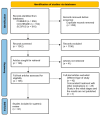Antidiabetic Treatment and Prevention of Ischemic Stroke: A Systematic Review
- PMID: 39407846
- PMCID: PMC11476433
- DOI: 10.3390/jcm13195786
Antidiabetic Treatment and Prevention of Ischemic Stroke: A Systematic Review
Abstract
Background: Diabetes mellitus (DM) is a prevalent disease in the general population and also a well-established risk factor for the development of ischemic stroke. Patients who have been diagnosed with diabetes have a 20% higher risk for developing ischemic stroke in comparison to non-diabetic individuals. The aim of the current systematic review is to provide the latest evidence regarding the association between antidiabetic treatment and the prevention of ischemic stroke. Methods: A comprehensive search in scientific literature databases PUBMED, COCHRANE, and SCOPUS was conducted. The studies that were deemed as eligible for this review were those that examined the clinical benefits of therapeutic strategies in terms of preventing ischemic strokes. Results: A total of 32 studies met the established selection criteria. The included studies showed that pioglitazone treatment significantly reduced the risk for recurrent stroke in patients with DM. Furthermore, in the context of primary prevention, the improvement in glycemic control after treatment with the glucagon-like peptide-1 receptor agonists (GLP-1RA) semaglutide and dulaglutide was associated with a reduction in the risk of ischemic stroke in diabetic subjects. Metformin monotherapy may reduce stroke risk, while dipeptidyl peptidase 4 inhibitors, sodium-glucose co-transporter 2 inhibitors, and insulin do not seem to affect the incidence of stroke. Conclusions: The findings of the present systematic review suggest that pioglitazone and GLP-1RA may decrease the risk of stroke. Further studies are needed to provide additional data regarding the preventive effect of novel antidiabetic drugs, such as dual glucose-dependent insulinotropic polypeptide/GLP-1RA agents, on stroke.
Keywords: antidiabetic drugs; diabetes; dipeptidyl peptidase 4 inhibitors; glucagon-like peptide-1 receptor agonists; ischemic stroke; metformin; pioglitazone; prevention; sodium-glucose co-transporter 2 inhibitors; tirzepatide.
Conflict of interest statement
The authors declare no conflicts of interest.
Figures
References
-
- Sun H., Saeedi P., Karuranga S., Pinkepank M., Ogurtsova K., Duncan B.B., Stein C., Basit A., Chan J.C.N., Mbanya J.C., et al. IDF Diabetes Atlas: Global, regional and country-level diabetes prevalence estimates for 2021 and projections for 2045. Diabetes Res. Clin. Pract. 2022;183:109119. doi: 10.1016/j.diabres.2021.109119. - DOI - PMC - PubMed
-
- Rawshani A., Rawshani A., Franzén S., Sattar N., Eliasson B., Svensson A.M., Zethelius B., Miftaraj M., McGuire D.K., Rosengren A., et al. Risk Factors, Mortality, and Cardiovascular Outcomes in Patients with Type 2 Diabetes. N. Engl. J. Med. 2018;379:633–644. doi: 10.1056/NEJMoa1800256. - DOI - PubMed
-
- Gomez-Peralta F., Escalada San Martín F.J., Menéndez Torre E., Mata Cases M., Ferrer García J.C., Ezkurra Loiola P., Ávila Lachica L., Fornos Pérez J.A., Artola Menéndez S., Álvarez-Guisasola F., et al. Spanish Diabetes Society (SED) recommendations for the pharmacologic treatment of hyperglycemia in type 2 diabetes: 2018 Update. Endocrinol. Diabetes Nutr. 2018;65:611–624. doi: 10.1016/j.endinu.2018.08.004. - DOI - PubMed
Publication types
LinkOut - more resources
Full Text Sources
Miscellaneous



